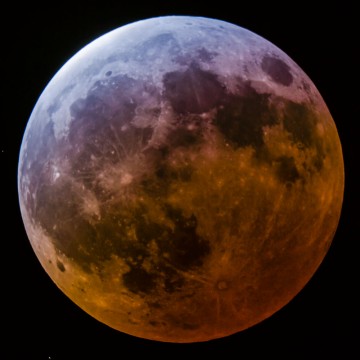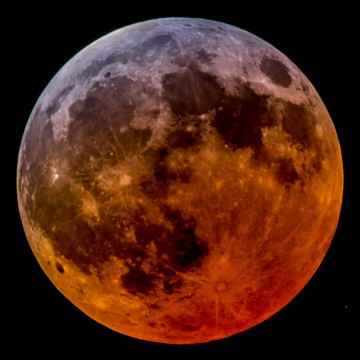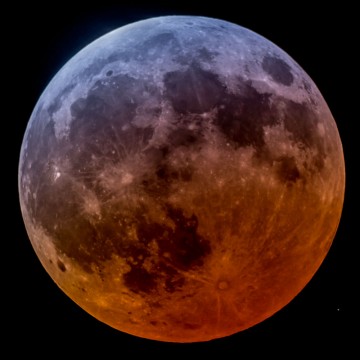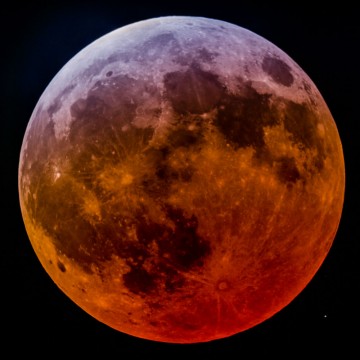In a borderline eclipse of the Moon like last Saturday's, the difference between "total" and "partial" depends on some crucial assumptions. Here's the whole story at last.




An especially intriguing eclipse of the Moon delighted observers from western North America to Australia and the Far East last Saturday (April 4, 2015). What still makes it so intriguing, several days later, is the question of whether the world saw a barely total lunar eclipse — the third in a "tetrad" of four, as almost universally predicted — or a barely partial lunar eclipse, with a hair-thin rim of sunlit lunar surface remaining just outside the umbra of Earth's shadow. Which would spoil the tetrad.
Visual observers are saying it was barely partial.
You'd think astronomers would be awfully embarrassed not to get such a simple prediction right. But the edge of Earth's umbra is fuzzy enough, and the umbra just inside the edge is bright enough — and the effects of Earth's atmosphere on the umbra's precise size are unpredictable enough — that we may never be sure which kind of eclipse we saw on Saturday.
The evidence certainly leans toward partial in terms of how people judge what they saw. But the most detailed mathematical analysis says it was theoretically total by a hair... probably.
Views of the Lunar Eclipse
"I observed the eclipse from San Francisco, naked eye and through mounted 11×56 binoculars," writes Anthony Barreiro in a typical report. "At no time did the eclipse appear total to me. The Moon’s far northern limb remained brightly illuminated throughout. Inside the apparent edge of the umbra the Moon’s surface was bright but obviously reddened. The very edge of the Moon remained much brighter and without any visible reddening."
Scott Bulkley, who has observed lunar eclipses for more than 50 years, used naked-eye observations, 10×50 binoculars, and a 5-inch Schmidt-Cassegrain telescope for this one. "Using all three viewing methods during the critical minutes, I was not able to observe totality at any time," he writes. "There was always at least a very thin ‘sliver’ of brightly illuminated lunar surface on the northern limb of the Moon."
Alastair from New Zealand writes, "I am sure this was not a fully total eclipse. A thin sliver of the limb was still quite brightly illuminated throughout totality."
All the other reports we’ve received so far agree.
But the problem with such reports is that the innermost penumbra — the portion of Earth's shadow just outside the umbra — was not necessarily in view, so there was nothing that the relatively bright umbral rim could definitely be compared against.
Nor does imaging help. Imaging is actually worse for determining the umbra's edge, because the amount of exposure, contrast, dynamic range and so forth can vary far more between different images than between different people's eyes at a telescope. Not to mention the tweaking and processing that may happen automatically in the camera, or by the photographer to "correct" the image later.
Eclipse Theory and Eclipse Observation
Wouldn't the simple geometry of the Earth, Moon, and Sun — known with extreme precision — give an exact answer?
The problem here is that Earth's atmosphere enlarges Earth's size, for shadow-casting purposes, by a not-quite-exact amount. The U.S. Naval Observatory, in its lunar-eclipse predictions, adds a standard 2% to the umbra's "geometric" radius to account for the effect of the atmosphere. This led the USNO to predict 12.2 minutes of totality. The French national almanac office, and eclipse predictor Fred Espenak, used the supposedly more sophisticated "Danjon method." This gave 4.7 minutes of totality and a much thinner margin for error.
However, in the days before the eclipse, Chicago amateur Curt Renz pointed out that neither method includes Earth's oblateness. Our planet is 1⁄300 less wide from pole to pole than it is across the equator (due to rotation). And Earth's far northern latitudes were the parts that cast the shadow's eclipse-defining northern edge.
Normally Earth's oblateness is insignificant. But in such a borderline case, might it tip the eclipse into being partial?
David Herald has carried this possibility through a full analysis, including both the oblateness and the best new information about the size of the umbra from a massive study of lunar eclipse crater timings recently done by himself and Roger Sinnott. Herald writes,
The most recent approach (Herald & Sinnott, JBAA 124-5 pp. 247-253, 2014) is based on the Danjon approach; however it treats the Earth as oblate, allows for the varying inclination of the Earth relative to the Sun during the year, and increases the Earth’s [shadow-forming] radius by 87 km — that being the best fit to 22,539 observations made between 1842 and 2011. For this eclipse the magnitude is computed as 1.002.
In other words, total by just one part in 500 in term's of the umbra's radius! "However," Herald continues,
the increase in the Earth’s [apparent] radius required to fit the [historical] observations is not a straightforward issue. When you analyse the distribution of observations, you find there is a significant difference between the modal (78 km), median (85 km) or mean (86.9 km) values of the distribution. We adopted the mean value.
With a magnitude of 1.002, the theoretical edge of the umbra was beyond the limb of the Moon by a mere 4.6 arcseconds at maximum eclipse. This is quite small compared to the extent of the transition at the edge of the umbra.
The magnitude of this latest eclipse, computed using the various values, comes out as:
Modal (78 km): mag = 0.999
Median (85 km): mag = 1.001
Mean (86.9): mag = 1.002Unless you have a clear understanding of the nature of the statistical variation, and the basis on which you are computing the magnitude of the eclipse, you may well be misled into the conclusions to be drawn from a small sample of observations. Given a statistically large number of observers, for this eclipse one would expect that the ‘most common’ estimate of the magnitude would be 0.999, that there would be as many estimates smaller than 1.001 as those larger than 1.001, and that the overall average of all estimates would be 1.002.
In short – those expecting a single well-defined value are doomed to disappointment.
The umbra does at least have an edge that's precisely definable, regardless of how the eye and brain might judge it. That edge is the place in the fuzziness where the change in brightness from point to point is steepest. This is the most natural definition of the umbra's edge, and the one that visual observers generally try to use when timing when the edge crosses craters and other lunar markings. These timings provide the best fix we have on what the umbra actually does.
But there's more uncertainty too! Sinnott and Herald also found that from one eclipse to the next, the atmosphere's effective eclipsing layer can differ in thickness by a few kilometers for reasons unknown. Unpredictably. They describe their work in the forthcoming June issue of Sky & Telescope.
We don't yet know how many people may have done good crater timings for this particular eclipse.
So, was it total or partial?
Visual observers seem to agree that it appeared partial. But by the exact definition of the umbra's edge? We'll probably never know.
For a closer look at our nearest celestial neighbor, check out our Moon globe, pieced together from thousands of Lunar Reconnaissance Orbiter images.
And to prepare for the last of the tetrad on September 27th, be sure to download our free lunar eclipse ebook to get a play-by-play of the celestial event plus a free Moon map.
 13
13
Comments
April 6, 2015 at 7:39 pm
Not sure if this helps the debate or not but: because of the tilt of the Earth's axis so close to the March Equinox, "north point" or "top" of the umbra corresponded to a point about 67degrees north longitude on the Earth. It's the same reason for the path of the March 20 solar eclipse: As seen from space, the Moon's shadow moved right to left - "West" to "East" as seen in space - but projected onto the earth, tilted 23 degrees to the eastern side of the planet, the Earth's North Pole was not "due north" but it was 23 degrees "below" true north and fell in the path of the shadow. As seen on a globe, the path was not West to East, but Southwest to Northeast.
I'm not sure if the 23 degree difference in oblateness between 67 degrees and 90 degrees North is enough to make a difference in the size of the shadow. Also, I'd read that the earth isn't really oblate but more pear-shaped, due to all the landmasses in the Northern Hemisphere compared all the ocean in the Southern Hemisphere. It's that's true then then top of the shadow fell closer to the "flattest" part of the Earths' shape (least distance from the Earth's center).
You must be logged in to post a comment.
Curt Renz
April 7, 2015 at 5:21 pm
@misha17
A limb of the Moon during every borderline eclipse passes close to a point on the umbra that corresponds with a point within several degrees of an arctic/antarctic circle, no matter whether near the time of an equinox or solstice. It would be exactly so, if the lunar orbit coincided with the ecliptic, but it actually intersects the ecliptic by 5°. That corresponding point on the Earth is always further from the Earth's center than either pole is, but closer than in the cases of the equator or even latitude 45° that Espenak uses for lunar eclipse predictions.
The pear-shape is a very minor consideration, with sea level near the South Pole being about 40 meters nearer to the Earth's center than it is near the North Pole.
You must be logged in to post a comment.
Peter Wilson
April 6, 2015 at 7:53 pm
Was watching "totality" from my suburban front porch, when a gaggle of dogs in the distance began barking hysterically, like I've never heard before. They sounded panicked; almost terrified. "The Moon!" "It's gone!" "OMG!," they seemed to be yelping, over and over. Just as suddenly, they quieted.
The dogs acted like the eclipse was total, but they may not have been thinking clearly. I vote barely partial.
You must be logged in to post a comment.
April 7, 2015 at 4:47 pm
I'm a little surprised people didn't consult the internet to see where the best views would be. Prior to the eclipse, I visited: http://www.timeanddate.com/eclipse/lunar/2015-april-4 - and it clearly shows that the West coast was not going to be total.
You must be logged in to post a comment.
Anthony Barreiro
April 7, 2015 at 5:38 pm
A lunar eclipse will appear the same from everywhere on the side of the Earth that can see the eclipse. If you see a total lunar eclipse from one place on the surface of the Earth, it will be total from everywhere. Likewise if the eclipse is partial from one place it will appear partial everywhere. At the distance of the Moon's orbit, the Earth's shadow is bigger than the Moon, so the whole Moon either moves into the shadow or it doesn't.
Solar eclipses are very different in this regard. The Moon's shadow covers only a small area on the Earth's surface, so you need to be within a few kilometers of the centerline of a total solar eclipse to see totality. Outside that narrow band, the eclipse will appear only partial.
You must be logged in to post a comment.
Curt Renz
April 7, 2015 at 5:39 pm
@RadRich
That chart you linked appears to have misled you. The Moon was above the horizon for North American west coast observers at the time of maximum eclipse. The chart appears to be showing the percentage of time that the umbral (combined partial and total) phase would be visible for various locations, not the maximum percentage of the Moon's diameter that would be in the umbra. Any observer at a location on that chart showing an expectation of viewing greater than 50% of the eclipse, would have been able to see the eclipse at maximum obscuration (assuming no cloud interference).
In any event, I predicted that for this eclipse the Moon likely would never become totally eclipsed. The majority of people reporting their observations seem to agree. I hope this convinces the go-to eclipse authorities to be more attentive to detail, and for the media to be more questioning of what they are told.
You must be logged in to post a comment.
Anthony Barreiro
April 7, 2015 at 7:57 pm
In a comment on Kelly Beatty's story about this controversial lunar eclipse, "Frank-ReedNavigation.com" explained the pros and cons of using standardized assumptions when predicting the extent of lunar eclipses. This most recent lunar eclipse suggests to me that there seem to be three possible conditions for lunar eclipse predictions: definitely total, definitely partial, and too close to call. Saturday’s eclipse at a standardized predicted extent of 1.005 apparently was within the margin of error and therefore too close to call in advance.
I’m curious about the extent of this range of uncertainty. Would a standardized prediction of 0.99 definitely be partial and 1.01 definitely total? Would we be uncertain if the predicted extent were between 0.95 and 1.05? How wide is the margin for error?
And once the range of uncertainty is defined, how frequently do these fascinating liminal eclipses occur? Will I get to see another during my lifetime? Whoops, there's another undefined quantity!
It was a lovely eclipse to watch, and the discussion before and after has made it even more interesting.
You must be logged in to post a comment.
Ted-Hauter
April 7, 2015 at 11:33 pm
From my city sea side residence, I was in awe on that night as the moon traveled low to the dark watery west. To have so much light everywhere but this patch of sky topped off by a near total - that seemed to last forever! What a joy to see this sight in a patch of sky as it is supposed to be... what a miracle to behold our universe.
You must be logged in to post a comment.
Russ
April 8, 2015 at 2:46 am
My opinion on the total or partial eclipse question is that it's only an academic discussion, albeit a very interesting one. And I appreciate what others have shared. But the way it looked to my eye or in my photos above didn't depart enough from the total eclipse effect to ruin the beautiful view. The thin sliver of bright lunar surface was just the "icing" on the bluish cast of the outer umbra. If it had been total rather than partial, there would just be a tiny sliver of the Moon that would have been darkened, not enough to change the overall appearance. Of course if the eclipse had been much more a definite partial eclipse, the added light would have greatly affected the appearance, muting the beautiful colors. It was one of the most memorable eclipses of the many I've seen. It was likely the brightest one, which compares to the darkest from years ago in the mid-60's when the Moon couldn't be seen with the unaided eye. Each one is unique, and the current one is certainly so. We can look forward to the upcoming September 27-28, 2015 eclipse.
You must be logged in to post a comment.
SkyandClouds
April 11, 2015 at 3:11 am
First eclipse that I ever saw was also the darkest. I observed it while driving south on the freeway, late evening and the moon was burgundy in color. To see it required glancing quickly at it as it hovered low and large in the eastern sky like a ball on a string. That was back in the late sixties to early seventies before looking eclipses up was easy and before public interest in these things was common. There was nothing to find on the news about it and wish I had recorded the date. None that I have seen since were as deeply colored. This most recent eclipse was light, almost pinkish, darkening just a bit as it lowered in the west in early morning daylight.
You must be logged in to post a comment.
Oldster
April 10, 2015 at 9:31 pm
From my vantage point in Concord, CA, just east of San Francisco, it looked total to me using only naked eye. However, I arose about 3 minutes before predicted totality, and only watched for about 10 minutes, so I saw none of the partial phases for comparison ...
You must be logged in to post a comment.
SkyandClouds
April 11, 2015 at 2:48 am
Read somewhere that light could have curved around and therefore lit that sliver of the moon during 'totality.' Any guesses on how Einstein would have resolved this question of the eclipse?
You must be logged in to post a comment.
Glenn
April 15, 2015 at 12:57 am
An interesting debate on the partial/total eclipse. I battled clouds from the city of Bathurst NSW Australia where "totality" was at a not too late 11pm daylight saving time. Nice lilacs from the ozone layer adsorption of the red end of the spectrum. Now here's some mental gymnastics. Imagine you were standing on the moon inside the crater Plato. The sun is about 30 degrees above the horizon and the 2 degree wide Earth covers the 0.5 degree sun with plenty to spare. Now move north to a point which from Earth is at the lunar rim located about where the craters Anaxagorus or Philoaus lie. Any further and the Earth will not appear above your horizon - you will be on the far side of the moon. So back to Anaxagorus. You are looking back at Earth tangentially to the lunar surface and theoretically can glimpse ice in the Arctic Ocean as your line of sight skims the polar region also at a tangent.
The Earth begins to cover the sun but it's below your horizon. The eclipse proceeds and if it is total no bright sliver of sunlight is visible although the 3 arcsecond wide atmosphere will be a brilliant red nearer Earth with lilac higher up. If the eclipse is partial a golden sliver of sunlight should appear for a few minutes, directly illuminating the crater without any refractive effects. Of course the atmosphere does not suddenly stop at 10 or 100 km with the latter distance being significant when considering Earth's oblate shape and polar diameter 22 km less than its equatorial.
Good luck to the mathematicians. Can they prove or disprove that an Anaxagorasian observer would have seen sunlight?..... Glenn
You must be logged in to post a comment.
You must be logged in to post a comment.